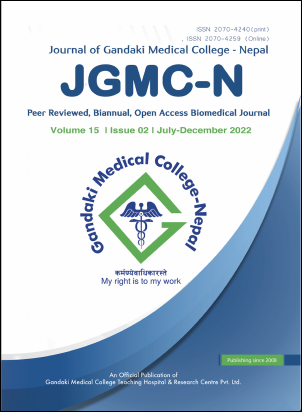Clinico-epidemiological presentation of acute encephalitis syndrome in patients visiting a tertiary hospital in Kathmandu, Nepal: A descriptive cross-sectional study
DOI:
https://doi.org/10.3126/jgmcn.v15i2.44719Keywords:
Acute encephalitis syndrome, altered sensorium, Japanese encephalitisAbstract
Introduction: Acute encephalitis syndrome is diagnosed when a person of any age, and at any time of the year, presents with the acute onset of fever and a change in mental status and/or new onset of seizures. It has an ill-defined clinico-epidemiological presentation in Nepal, making it a challenging medical condition. The objective of this study was to study the clinical profile of acute encephalitis syndrome.
Methods: All consecutive admissions at Tribhuvan University Teaching Hospital between April 2017 and December 2018 were screened for acute encephalitis syndrome. The diagnosis was confirmed by history, examination, laboratory findings, brain imaging, and electroencephalography. All patients who met the inclusion criteria were enrolled. For data entry and analysis, statistical package for the social sciences software version 16.0 was used. Descriptive statistics as frequencies and mean ± standard deviations were computed.
Results: The mean age of the study population was 49.56±22.28 years with male predominance 42(58.3%). Among the diagnosed etiologies, 1.38% had Japanese encephalitis, 4.12% had herpes encephalitis, and 4.12% had autoimmune encephalitis. Out of the 72 patients, 52 patients (72.22%) had Glasgow coma scale >12, 15 patients (20.83%) had 8 to 12, and five patients (6.94%) had coma (Glasgow coma scale <8). Among the clinical findings, altered mental status (91.66%) was the most commonly noticed manifestation followed by fever.
Conclusions: Most patients had altered sensorium with less severe brain injury based on the Glasgow coma scale score during the presentation. Its low diagnostic yield, however, often leads to an increase in unknown etiologies. The syndrome was more prevalent in hilly regions.
Downloads
Downloads
Published
How to Cite
Issue
Section
License
Copyright (c) 2022 Bidhi Dhital, Neeti Bhat

This work is licensed under a Creative Commons Attribution-NonCommercial 4.0 International License.
This license allows reusers to distribute, remix, adapt, and build upon the material in any medium or format for noncommercial purposes only, and only so long as attribution is given to the creator.

